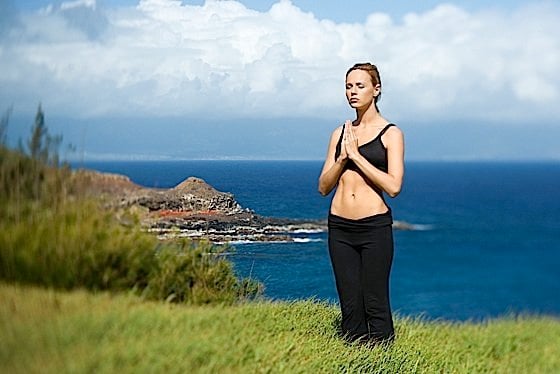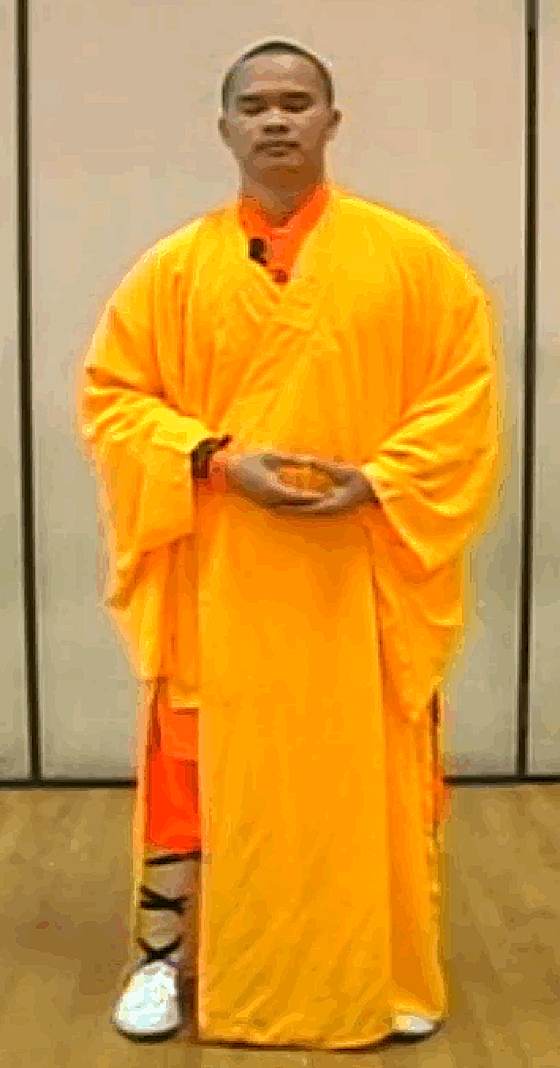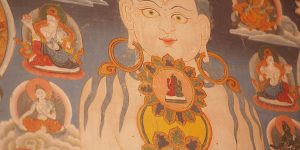The Better Way: Standing Meditation? For those with injuries, arthritis or a sleepy mind, standing can help us achieve mindfulness
“You can meditate walking, standing, sitting or lying down” Buddhist monk Noah Yuttadhammo. “Standing is a moderate form, and can be used to calm you down or wake you up.”
For some of us, with sports injuries, arthritis or conditions that prohibit lengthy sitting, standing meditation is a better way to achieve mindfulness. Sitting meditation might be too painful, the obstacles too great and walking meditation requires extraordinary concentration.
Korean Zen Master Kusan said: “In 1943… I decided to fight my drowsiness by meditating in the standing posture with palms together in front of me (hapchang). … Remaining alone, I decided that I wouldn’t give up under any pretext, even if I were about to die – such was my determination to continue.”

Some teachers and gurus teach standing mindfulness meditation in addition to sitting practice. In some traditions standing meditation is considered superior for aligning “the meridians” and chakras and for flow of energy. There is a definite benefit in terms of mindfulness, since it is easy to remain mindful when standing since drowsiness is rarely an issue. In the Shaolin tradition, training begins with standing meditation and full lotus-like postures are only for senior meditators.
“You can meditate walking, standing, sitting or lying down,” said Buddhist monk Noah Yuttadhammo. “Each requires a different degree of effort as opposed to degree of concentration. Walking meditation having the highest degree of effort, lying meditation having the highest degree of concentration.”
He explains that standing and sitting meditation are nearly equal in terms of technique and results, with standing requiring less concentration than sitting but more effort physically. “Standing meditation is a moderate form, and can be used to calm you down or wake you up.”
Martial artists emphasize standing meditation
Nearly all martial arts have a tradition of momentary standing meditation at the beginning and end of practice, while seriously spiritual martial artists make serious mindfulness meditation a centerpiece of daily practice. Martial artists claim the improvement to breathing, posture, and concentration make them batter at their art, while the spiritually inclined find rapid progress in their meditation practice.
Is one superior to the other? The answer, clearly, is no, but there are relative advantages to both. I practice both lotus and standing, and must admit that standing is easier to maintain in the longer sessions. A certain level of fitness is required, which is why standing meditation is a major component of Yiquan and ChiGong (ChiKong) health practices.
How long can you stand?
Hours easily, if you’re either fit, or trained, or a non-sedentary worker. Since I stand all day in my “job”, standing for meditation is fairly straight forward and strain free even after four hours of standing meditation. For me, sitting meditation requires training, because my body doesn’t like sitting and I can barely manage an hour. For others, perhaps office workers, the opposite would be true, with sitting meditation easier to begin with than standing, although full lotus—known for it’s valuable chakra alignment and energy benefits—is not so easy without training.
Live in the moment, stand in the moment
Ultimately, since mindfulness trains us to live in the moment, the fewer distractions (pain, a position we’re uncomfortable with, numb muscles or posterior) are all bad. Many of my friends complain that their legs go numb in sitting. When I explain standing meditation I get a “huh?” look. But my teacher advocates standing, and I strongly recommend it. If you are used to standing, and get numb sitting (or have arthritis in the knee, for example) the benefits of standing are strong. If you are used to sitting, and find standing tiring, you might opt for sitting to slip more easily into mindfulness—although standing might be a useful discipline to develop for further practice and for your health.
Basic Standing Meditation
1. Stand in one place, with knees very slightly bent so that back straightens and weight centers over balls of the feet. Slightly turn toes in (not too much!) with legs shoulder width apart.

2. In Chi Qong or Yiquan—which has health and medical benefits (even the removal of disease according to the classics—we are taught the principle of “balls”. Hold arms slightly up so that a “tennis ball” would fit under arms, and gently wrap arms at chest height with fingers loose as if hugging a beach ball. (See Standing Meditation Basics video). It is also useful training for martial artists, as well as a superb method of practicing mindfulness. For more traditional Buddhist meditation, allowing the arms to hang loosely in front, with arms cupped palms up, thumbs out (similar to sitting posture hand position) is useful, since there’s no muscular strain.
3. Try to relax and breathe normally and concentrate on the breath, only the breath. There’s no difference between standing and sitting on the breathing tips, but generally to breathe properly, your shoulders should not be moving up and down. This is called diaphragmatic breathing. This process cleans toxins from the body.
4. When you have the breathing method down, you are ready to close your eyes, and begin counting breaths, or using any other method you practice, such as fire breath, deep breathing, and so on. Some, might concentrate on their bodies and how their muscles feel in the posture and remain mindful of that. Still others follow their breath. Advanced practitioners use various techniques.
5. Depending on your practice, you could also recite mantras, visualize deities, concentrate on chakras or any other form of practice, all while standing.
6. Eyes can be closed or half closed as your prefer for your visualization or mindfulness practice.
Other tips from experts
Suggestions from the Wat Thai Temple
“Standing and walking meditation, in the first place, is a very good supplement to meditation in the sitting position. It can be alternated with sitting meditation. It is a good practice for those of us who are having trouble keeping the mind alert or even staying awake. It adds a little vitality and vigor to our meditation. It may be done indoors, e.g., in the ordination hall, or outdoors. If weather permits, it is a good idea to do it outside in the fresh air. We choose a place about twenty-five paces long on level ground and stand at the end of our path. We can let our hands hang down at our sides, or clasp them in front of us or behind us. This time we certainly want to keep our eyes open! We look at the ground about ten feet in front of us and try not to get distracted by what is going on around us.
We first do a sweep of the body, examining every part from the top of the head to the tips of the feet to relax ourselves. (There is more energy involved in standing and walking meditation than in sitting meditation, but it, too, is intended to produce tranquility.) We do a sweep, also, to bring our minds to a focus on the body. In standing and walking meditation our minds are involved in the contemplation of various motions and placements of the feet and legs, so this is all the more reason for beginning with a close examination of the body. “
5 thoughts on “The Better Way: Standing Meditation? For those with injuries, arthritis or a sleepy mind, standing can help us achieve mindfulness”
Leave a Comment
More articles by this author

Chintachakra White Wish-Granting Wheel Tara: The All-in-One Mother of Buddhas in Vajrayana Buddhism – Her Significance, Mantra and Why Her Practice is Essential

The First Doctor: Medicine Buddha Bhaisajyaguru Lapis Lazuli Light — Empowering You to Heal; the Buddha of Healing and Medicine and Doctors

Upaya: Is Skillful Means, Imagination and Creativity the Path to Realizations? Experiential Buddhist Practice or Yogas Enhance Intellectual Study.
Search
Latest Features
Please support the "Spread the Dharma" mission as one of our heroic Dharma Supporting Members, or with a one-time donation.
Please Help Support the “Spread the Dharma” Mission!

Be a part of the noble mission as a supporting member or a patron, or a volunteer contributor of content.
The power of Dharma to help sentient beings, in part, lies in ensuring access to Buddha’s precious Dharma — the mission of Buddha Weekly. We can’t do it without you!
A non-profit association since 2007, Buddha Weekly published many feature articles, videos, and, podcasts. Please consider supporting the mission to preserve and “Spread the Dharma." Your support as either a patron or a supporting member helps defray the high costs of producing quality Dharma content. Thank you! Learn more here, or become one of our super karma heroes on Patreon.
Lee Kane
Author | Buddha Weekly
Lee Kane is the editor of Buddha Weekly, since 2007. His main focuses as a writer are mindfulness techniques, meditation, Dharma and Sutra commentaries, Buddhist practices, international perspectives and traditions, Vajrayana, Mahayana, Zen. He also covers various events.
Lee also contributes as a writer to various other online magazines and blogs.
















Thank you for this. I recently starting doing standing mediation and I find it very powerful and useful. Time seems to go by very quickly and my concentration is deep.
It is all a best idea to alleviate the suffering
I am very interested in learning the correct position of meditation.
Thank you for sharing.
Thank you for providing this article. I have also written an article on Standing Meditation on my website. I am just starting to practice on a regular basis.
Thank you for your content, this article is helpful to me, I am also a fan of standing meditation, and I also have some insights on my blog.